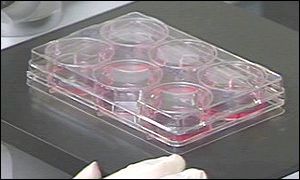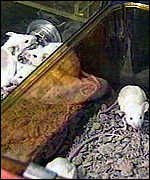Spinal Paralysis Breakthrough
![]()
Spinal paralysis 'breakthrough'
Spinal Paralysis Breakthrough
![]()
Spinal paralysis 'breakthrough'

A team from Johns Hopkins University in Baltimore have restored movement to paralysed mice and rats by injecting immature stem cells into the animal's spinal fluid.
The animals were paralyzed by introducing an animal virus that specifically attacks motor neurons (the cells that co-ordinate movement).
Stem cells could be used in early clinical trials within two years
|
|
Dr Jeffrey Rothstein, Johns Hopkins University
|
They drag legs and feet behind the, mimicking symptoms found in patients with a disease called spinal muscular atrophy (SMA).
But half of the rodents treated with stem cells recovered the ability to place the soles of one or both of their hind feet on the ground.
Researcher Dr Jeffrey Rothstein said: "This research may lead most immediately to improved treatments for patients with paralyzing motor neuron diseases, such as amyotrophic lateral sclerosis (ALS) and SMA.
"Under the best research circumstances, stem cells could be used in early clinical trials within two years."
Broad effect
Dr Douglas Kerr, who led the research team, said the study was significant because it was one of the first to demonstrate stem cells have the potential to restore function over a broad region of the central nervous system.

The research was carried out on mice
and rats
|
In the rodent study, however, injected stem cells migrated to broadly damaged areas of the spinal cord.
Dr Kerr said: "Something about cell death is apparently a potent stimulus for stem cell migration.
"Add these cells to a normal rat or mouse, and nothing migrates to the spinal cord."
In the study of 18 rodents, the researchers injected stem cells into the animals' cerebrospinal fluid via a hollow needle at the base of the spinal cord.
Within several weeks, the cells migrated to the ventral horn, a region of the spinal cord containing the bodies of motor nerve cells.
Between 5% and 7% of the stem cells turned into fully functioning nerve cells, enough to restore some movement within eight weeks in half of the rodents.
The scientists are now trying to discover how it is possible that such an apparently small number of nerve cells can make such a significant difference to the animals' capacity to move.
Inherited disorder
SMA is the most common inherited neurological disorder and the most common inherited cause of infant death. The gene for the disease is carried by one in 40 people.
Both parents need to be carrying the gene before a child develops the condition. The disease causes nerve cells leading from the spinal cord to muscles to deteriorate.
Children are born weak and have trouble swallowing, breathing and walking. Most die in infancy, though some live into young childhood.
In the UK, Anita MacAulay, executive director of the Jennifer Trust for Spinal Muscular Atrophy, welcomed the research.
She said: "This research is really exciting news and will be well received by the families of victims as it could make the day when SMA is thing of the past that much closer."
ALS causes the deterioration of motor nerves leading from the brain to the spinal cord as well as those from the cord to muscles. The disease eventually creates whole-body paralysis and death.
Ruth Obeten, superintendent physiotherapist at the Internal Spinal Injuries and Rehabilitation Centre at the Royal Buckinghamshire Hospital, said the technique could potentially also help patients with spinal injuries.
She said: "Maybe eventually if you inject these things into the spine immediately after injury you might get some re-growth of material.
"But spinal cord material dies off so quickly that unless it was done immediately there would be nothing left to re-grow."
The findings were presented at a conference of the Society for Neuroscience in New Orleans.
To see the actual article, go here: http://news.bbc.co.uk/hi/english/health/newsid_1004000/1004133.stm
![]()